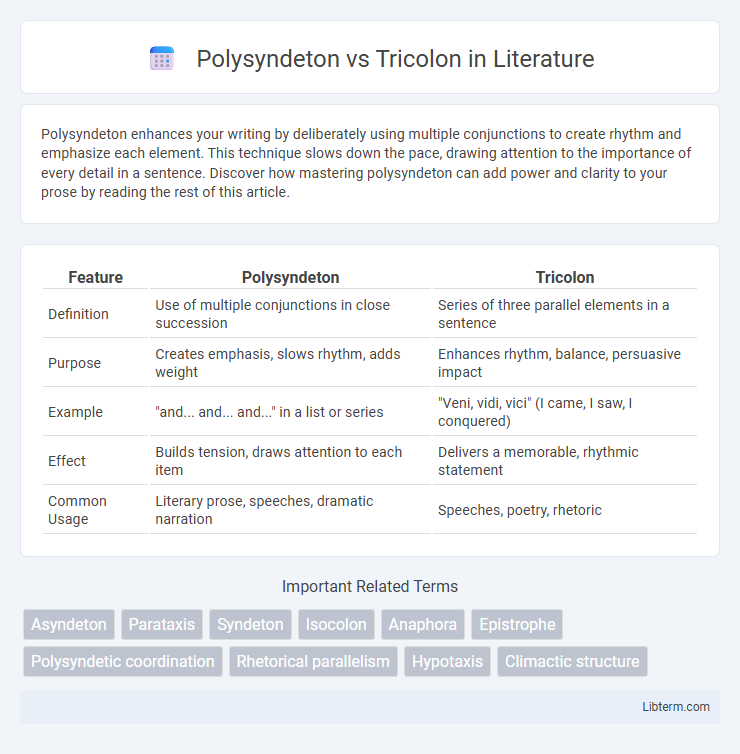Polysyndeton enhances your writing by deliberately using multiple conjunctions to create rhythm and emphasize each element. This technique slows down the pace, drawing attention to the importance of every detail in a sentence. Discover how mastering polysyndeton can add power and clarity to your prose by reading the rest of this article.
Table of Comparison
| Feature | Polysyndeton | Tricolon |
|---|---|---|
| Definition | Use of multiple conjunctions in close succession | Series of three parallel elements in a sentence |
| Purpose | Creates emphasis, slows rhythm, adds weight | Enhances rhythm, balance, persuasive impact |
| Example | "and... and... and..." in a list or series | "Veni, vidi, vici" (I came, I saw, I conquered) |
| Effect | Builds tension, draws attention to each item | Delivers a memorable, rhythmic statement |
| Common Usage | Literary prose, speeches, dramatic narration | Speeches, poetry, rhetoric |
Understanding Polysyndeton: Definition and Purpose
Polysyndeton is a rhetorical device that involves the deliberate use of multiple conjunctions between words, phrases, or clauses to create a sense of rhythm and emphasis. Its purpose is to slow down the pace of the sentence, enhance the cumulative effect, and convey intensity or overwhelming magnitude. This technique contrasts with tricolon, which relies on a series of three parallel elements without repeated conjunctions to achieve balance and memorability.
Tricolon Explained: Structure and Significance
Tricolon is a rhetorical device consisting of three parallel elements of equal length and importance, creating a rhythmic and memorable effect. Its structured tripartite construction enhances persuasion and emphasis by reinforcing ideas through repetition and balance. This technique, often used in speeches and literature, strengthens the impact of statements by appealing to the audience's sense of completeness and harmony.
Historical Origins of Polysyndeton and Tricolon
Polysyndeton, a rhetorical device characterized by the deliberate use of multiple conjunctions in close succession, traces its origins to Ancient Greek and Latin literature, where it was employed to create a rhythmic and emphatic effect in oratory and epic poetry. Tricolon, a stylistic term denoting a series of three parallel elements, also emerged from classical rhetoric, gaining prominence through the works of Cicero and Quintilian as a persuasive structure enhancing memorability and impact. Both techniques have been integral to classical rhetoric, shaping effective communication from antiquity to modern times.
Key Differences Between Polysyndeton and Tricolon
Polysyndeton employs the deliberate repetition of conjunctions between clauses or phrases, enhancing rhythm and emphasis, whereas tricolon structures ideas in a series of three parallel elements to create a memorable and balanced effect. Polysyndeton typically uses multiple conjunctions like "and" or "or" to slow pacing and add weight, while tricolon relies on the power of the number three to achieve rhetorical impact. Understanding these distinctions is crucial for writers aiming to manipulate sentence flow and persuasive strength effectively.
Effects on Rhythm and Emphasis in Writing
Polysyndeton employs repeated conjunctions to create a deliberate, measured rhythm that slows reading pace and heightens emphasis on each element, enhancing dramatic intensity. Tricolon uses a series of three parallel elements to generate a balanced, rhythmic pattern that reinforces memorability and persuasive impact through concise, rhythmic repetition. Both devices manipulate sentence structure to influence pacing and focus, but polysyndeton emphasizes continuity and accumulation, while tricolon highlights balance and climax.
Polysyndeton and Tricolon in Classical Literature
Polysyndeton and tricolon frequently appear in classical literature to enhance rhetorical impact and rhythm; polysyndeton involves the deliberate use of multiple conjunctions between clauses for dramatic effect, as seen in Homer's epics where repeated "and" emphasizes the scale of events. Tricolon features a series of three parallel elements, often used by Cicero to create memorable, persuasive passages structured with balanced, reinforcing ideas. These devices together contribute to the ornate and emphatic style characteristic of ancient texts, amplifying both emotional intensity and stylistic elegance.
Modern Uses in Speeches and Prose
Polysyndeton enhances rhetorical effect by deliberately using multiple conjunctions in speeches and prose to create a sense of rhythm and emphasis, often evoking emotional intensity or a feeling of overwhelming abundance. Tricolon, characterized by a series of three parallel elements, is widely employed in modern oratory and writing for its memorable and persuasive impact, reinforcing ideas through balanced, concise expression. Contemporary speakers and authors leverage polysyndeton to build dramatic tension and tricolon to deliver crisp, impactful messages that resonate with audiences.
Rhetorical Impact on Audience Engagement
Polysyndeton intensifies audience engagement by using repeated conjunctions to create a deliberate, rhythmic flow that emphasizes each listed element, generating a sense of overwhelming abundance or urgency. Tricolon, through grouping ideas in three parallel, balanced phrases, enhances memorability and rhetorical strength, making arguments more persuasive and impactful. Both devices leverage structured repetition to capture attention and reinforce key messages, but polysyndeton drives emotional involvement while tricolon reinforces logical clarity.
Common Mistakes and How to Avoid Them
Polysyndeton involves the deliberate use of multiple conjunctions between clauses, often to create emphasis or rhythm, but a common mistake is overusing conjunctions, which can make sentences feel cluttered and confusing. Tricolon is a rhetorical device consisting of three parallel elements, and a frequent error is failing to maintain balance and parallelism among the three parts, weakening the intended impact. To avoid these pitfalls, writers should ensure polysyndeton enhances clarity without redundancy and verify that tricolon elements are equally weighted and stylistically consistent.
Tips for Effectively Incorporating Both Devices
To effectively incorporate polysyndeton and tricolon, vary sentence rhythm by combining multiple conjunctions with a series of three parallel elements to create emphasis and balance. Use polysyndeton to slow the pace and add a sense of abundance or urgency, while tricolon provides a memorable, rhythmic structure that reinforces key points. Balance these devices by avoiding overuse, ensuring each element contributes meaningfully to clarity and persuasive impact.
Polysyndeton Infographic

 libterm.com
libterm.com